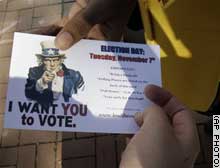There are references everywhere — I saw it on the news while I was travelling — but here’s an article at USA Today
IPSWICH, England — Tear down the traffic lights, remove the road markings and sell off the signs: Less is definitely more when it comes to traffic management, some European engineers believe.
They say drivers tend to proceed more cautiously on roads that are stripped of all but the most essential markings — and that helps cut the number of accidents in congested areas.
“It’s counterintuitive, but it works,†said urban planner Ben Hamilton-Baillie, who heads the British arm of a four-year European project, Shared Spaces, to test the viability of what some planners call “naked roads.â€
I often get confused driving around trying to parse the many signs everywhere, and wonder if they’re really helping things — and marvel at how ugly they are. It didn’t occur to me that a more ‘zen’ approach might be better, and possibly even safer. Fascinating how when you take away some of the cues, you force people to *think* as they drive. (As long as you have just enough other cues to keep them somewhat managed.)
In some ways it’s kind of a wikipediazation of public roadway signage. Rather than dictating every move, put just enough of the right cues out there to get people to structure their own behavior appropriately.



